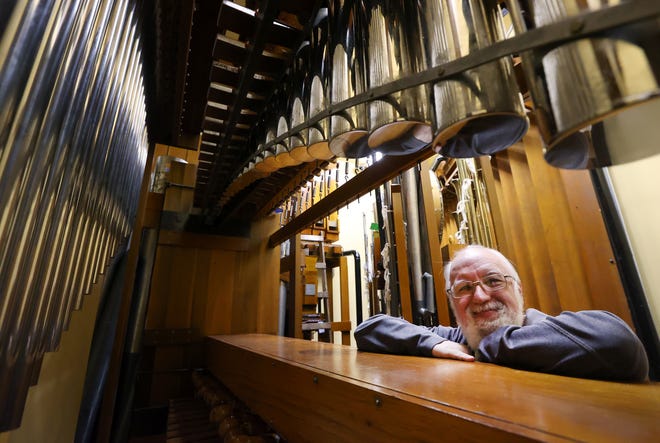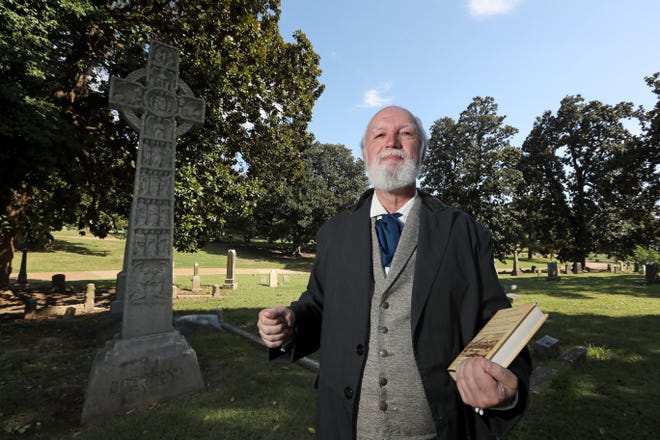
Whether holding court in a flowing white wedding dress as the beaming main attraction of a gay pride parade, coaxing showtunes from the keys and peddles of the Wurlitzer organ at the Orpheum or sharing his enthusiasm for his vast collection of movie theater memorabilia, Vincent Astor was a puckish, irrepressible avatar of Memphis at its most distinctive and independent — a community icon who made history even as he preserved it.
An unofficial chronicler of vintage Shelby County with a special interest in movie theaters, the Orpheum and the LGBTQ community, Astor was “an ‘out’ gay man in Memphis long before that was socially acceptable, when that was a courageous act,” said the Rev. Scott Walters, rector at Calvary Episcopal Church, where Astor was a longtime member with a deep knowledge of the congregation’s almost 200-year-old history.
“He lived a life where he really moved history forward,” Walters said.
“He was a true Memphis icon,” said Brett Batterson, Orpheum president and CEO. “He really loved this city.”
Astor, 69, was found dead Monday night by church friends at his apartment in Kimbrough Towers, after he had failed to respond to calls or texts. He had suffered from poor health in recent months, in part because of his diabetes, and apparently died of natural causes, according to friends.
A theatrical personality and eager raconteur with a short beard, lengthy repertoire of yarns and elephant’s memory, “Vincent Astor lived his life completely unabashed,” said his close friend Whit Grace, a history teacher. “He was a loving, caring, generous person.”
“He may have been on the short side, but he was truly larger than life,” said Memphis filmmaker and arts advocate Mark Jones, a longtime board member with OUTMemphis: The LGBTQ+ Community Center of the Mid-South, which Astor helped found in 1989.
“A quick wit, a sharp wit, he was always his own person,” Jones said. “He did not change when he was with certain groups of people. He was always ‘Lady A,’ as he referred to himself.”
A lifelong Memphian and graduate of what is now known as Rhodes College, Astor was familiar to many Memphians for his role as an advocate of local history, which made him a frequent and indispensable presence at classic movie screenings, local history lectures and various heritage events.
He was the longtime organist at the Orpheum, playing concerts before movies and other shows on the theater’s 1928 Wurlitzer (the song he played more than any other, he said, was “Never Never Land,” from the 1954 Broadway production of “Peter Pan”). He also gave tours of the theater, regaling visitors with spooky stories of “Mary,” the Orpheum ghost (a 12-year-old child supposedly struck by a trolley car near the theater in 1921).
He also was a dedicated chronicler of the history of movie exhibition in Memphis. His lavishly illustrated 2013 book “Images of America: Memphis Movie Theatres” presented the definitive history of the city’s cinemas, from the nickelodeons of the 1900s to the movie palaces of the mid-century to the multiplexes of the suburban malls. “It offers nostalgia and a touch of something beautiful,” Astor said of his book, inadvertently offering something of a mission statement for his dedication to collecting historic memorabilia.
But Astor’s nostalgia for old Memphis did not make him complacent. An “out” activist and pioneering force for meaningful recognition for the Memphis gay community, Astor wrote for such LGBT newspapers as Gaze and the Triangle Journal, spearheaded fundraising and awareness campaigns during the AIDS epidemic, was a flamboyant participant in pride parades (in 2006, he wore a tiara and a cape as “a card-carrying good fairy”) and championed drag shows and gay theater (he was Scrooge in a production titled “A Queer Carol”).
Rightly proud of his efforts, Astor ensured that his association with Memphis history will continue long after his death. He had donated much of his memorabilia to Rhodes, the University of Memphis, and the Memphis Public Libraries. His collection — including his signature button-festooned vest — provided a foundation for “Memphis Proud,” a groundbreaking exhibit recognizing the “Resilience” of Memphis’ “LGBTQ+ Community” that was on display last year at the Museum of Science and History.
“Memphis Proud” made national news in September when a “family-friendly” drag show and evening dance party scheduled in conjunction with the exhibit was canceled after armed protesters gathered in the museum parking lot to intimidate attendees. The incident showed that the causes Astor championed are hardly settled, even if drag shows are now, in fact, an officially recognized aspect of local history: In 2019, in response to the advocacy of Astor and Mark Jones, the Shelby County Historical Commission unveiled a marker outside Midtown’s Evergreen Theatre in recognition of the 50th anniversary of the “Miss Memphis Review,” a “public drag pageant” intended “to protest a city ordinance banning crossdressing.”
Astor also will be part of history at one of the city’s most famed sites: He will be buried at 170-year-old Elmwood Cemetery, where he gave tours and dressed as notable cemetery “residents” for “Soul of the City” tours. In fact, he already has an obelisk in place at his gravesite.

Kim Bearden, Elmwood executive director, said Astor designed his own monument. The obelisk is made from gray granite and contains two hinged panels that a visitor must open in order to see portraits of Astor. One is the more public “Vincent Astor”; the other features Astor in his drag persona of “Lady A.”
“It’s been up for several years, and Vincent was very proud of it,” Bearden said. “It’s a monument not just to one man’s life but to the struggles of the gay and lesbian community of Memphis.”
She said the obelisk is on the east side of the cemetery, not far from the main gate. A ham to the end, “He wanted to be close to the entrance so people could visit his grave more easily.”
Funeral arrangements are incomplete. Canale Funeral Directors has charge.







